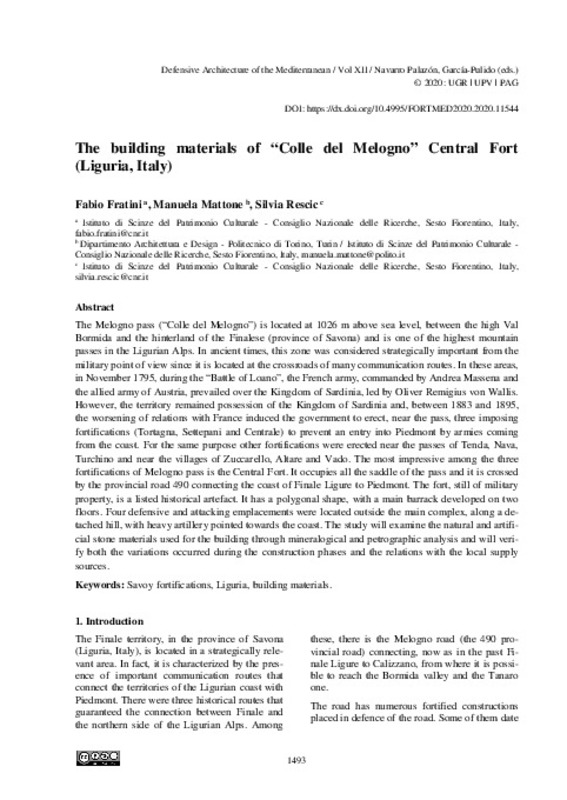JavaScript is disabled for your browser. Some features of this site may not work without it.
Buscar en RiuNet
Listar
Mi cuenta
Estadísticas
Ayuda RiuNet
Admin. UPV
The building materials of “Colle del Melogno” Central Fort (Liguria, Italy)
Mostrar el registro sencillo del ítem
Ficheros en el ítem
| dc.contributor.author | Fratini, Fabio
|
es_ES |
| dc.contributor.author | Mattone, Manuela
|
es_ES |
| dc.contributor.author | Rescic, Silvia
|
es_ES |
| dc.coverage.spatial | east=8.396493799999998; north=44.3167917; name=17047 Quiliano, Província de Savona, Itàlia | es_ES |
| dc.date.accessioned | 2020-07-17T11:36:30Z | |
| dc.date.available | 2020-07-17T11:36:30Z | |
| dc.date.issued | 2020-05-15 | |
| dc.identifier.isbn | 9788490488560 | |
| dc.identifier.uri | http://hdl.handle.net/10251/148205 | |
| dc.description.abstract | [EN] The Melogno pass (“Colle del Melogno”) is located at 1026 m above sea level, between the high Val Bormida and the hinterland of the Finalese (province of Savona) and is one of the highest mountain passes in the Ligurian Alps. In ancient times, this zone was considered strategically important from the military point of view since it is located at the crossroads of many communication routes. In these areas, in November 1795, during the “Battle of Loano”, the French army, commanded by Andrea Massena and the allied army of Austria, prevailed over the Kingdom of Sardinia, led by Oliver Remigius von Wallis. However, the territory remained possession of the Kingdom of Sardinia and, between 1883 and 1895, the worsening of relations with France induced the government to erect, near the pass, three imposing fortifications (Tortagna, Settepani and Centrale) to prevent an entry into Piedmont by armies coming from the coast. For the same purpose other fortifications were erected near the passes of Tenda, Nava, Turchino and near the villages of Zuccarello, Altare and Vado. The most impressive among the three fortifications of Melogno pass is the Central Fort. It occupies all the saddle of the pass and it is crossed by the provincial road 490 connecting the coast of Finale Ligure to Piedmont. The fort, still of military property, is a listed historical artefact. It has a polygonal shape, with a main barrack developed on two floors. Four defensive and attacking emplacements were located outside the main complex, along a detached hill, with heavy artillery pointed towards the coast. The study will examine the natural and artificial stone materials used for the building through mineralogical and petrographic analysis and will verify both the variations occurred during the construction phases and the relations with the local supply sources. | es_ES |
| dc.language | Inglés | es_ES |
| dc.publisher | Editorial Universitat Politècnica de València | es_ES |
| dc.rights | Reconocimiento - No comercial - Sin obra derivada (by-nc-nd) | es_ES |
| dc.subject | Fortifications | es_ES |
| dc.subject | Mediterranean | es_ES |
| dc.subject | Modern age | es_ES |
| dc.subject | Built Heritage | es_ES |
| dc.subject | Savoy fortifications | es_ES |
| dc.subject | Liguria | es_ES |
| dc.subject | Building materials | es_ES |
| dc.title | The building materials of “Colle del Melogno” Central Fort (Liguria, Italy) | es_ES |
| dc.type | Capítulo de libro | es_ES |
| dc.type | Comunicación en congreso | es_ES |
| dc.identifier.doi | 10.4995/FORTMED2020.2020.11544 | |
| dc.rights.accessRights | Abierto | es_ES |
| dc.description.bibliographicCitation | Fratini, F.; Mattone, M.; Rescic, S. (2020). The building materials of “Colle del Melogno” Central Fort (Liguria, Italy). Editorial Universitat Politècnica de València. 1493-1500. https://doi.org/10.4995/FORTMED2020.2020.11544 | es_ES |
| dc.description.accrualMethod | OCS | es_ES |
| dc.relation.conferencename | FORTMED2020 - Defensive Architecture of the Mediterranean | es_ES |
| dc.relation.conferencedate | Octubre 01-03,2020 | es_ES |
| dc.relation.conferenceplace | Granada, Spain | es_ES |
| dc.relation.publisherversion | http://ocs.editorial.upv.es/index.php/FORTMED/FORTMED2020/paper/view/11544 | es_ES |
| dc.description.upvformatpinicio | 1493 | es_ES |
| dc.description.upvformatpfin | 1500 | es_ES |
| dc.type.version | info:eu-repo/semantics/publishedVersion | es_ES |
| dc.relation.pasarela | OCS\11544 | es_ES |








